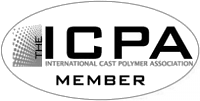Natural Stone Care and Maintenance
Natural Stone Care and Maintenance
To get the longest life and preserve the beauty of your natural stone, follow these simple tips:
Coasters: Use coasters under all glasses, particularly those containing alcohol or citrus juices.
Trivets: While many stones can withstand heat, the use of trivets or mats is recommended.
Spills: Blot the spill with a paper towel immediately. Don’t wipe the area, it will spread the spill. Flush the area with water and mild soap and rinse several times. Dry the area thoroughly with a soft cloth. Repeat as necessary.
Cleaning:
* Clean the stone with a neutral cleaner, stone soap, or a mild liquid dishwashing detergent and warm water.
* Similar to any item cleaned in your home, an excessive concentration of cleaner or soap may leave a film and cause streaks. Follow manufacturer recommendations.
* Use a soft cloth for best results
* Rinse the surface thoroughly after washing with the soap solution and dry with a soft cloth
* Change the rinse water frequently
Cleaning Products:
* Products containing lemon, vinegar, or other acids may dull or etch certain stones.
* Scouring powders or creams often contain abrasives that may scratch certain stones.
* Many commercially available rust removers contain trace levels of hydrofluoric acid (HF). This acid attacks silicates in addition to other minerals. All stones, including granite and quartzite, will be attacked if exposed to HF.
* Do not mix ammonia and bleach. The combination creates a toxic and lethal gas.
Sealing: Sealing is a common step taken on some stones as an extra precaution against staining. In face, the sealing products used in the stone industry are “impregnators” which do not actually seal the stone, but more correctly act a a repellent rather than a sealer. Sealing does not make the stone stain proof, rather it makes the stone more stain resistant. It is recommended that you reseal your granite once every year. You may purchase a granite sealer from your local home improvement store.
Stain Identification Tips: Identifying the type of stain on the stone surface is the key to removing it. Stains can be oil based, organic, metallic, biological, ink based, paint based, acid based. If you don’t know what caused the stain, consider likely staining agents that may have been present.
Stain Removal Steps: Surface stains can often be removed by cleaning with an appropriate cleaning product or household chemical.
The following section describes the types of stains you may have to deal with and the appropriate household chemicals to use and how to prepare and apply a poultice to remove the stain.
Oil Based (grease, plumbers’ putty, tar, cooking oil, milk, cosmetics)
An oil-based stain will darken the stone and normally must be chemically dissolved so the source of the stain can be flushed or rinsed away. Clean gently with a soft, liquid cleanser with one of the following: household detergent, mineral spirits, or acetone.
Organic (coffee, tea, wine, fruit, tobacco, paper, food, urine, leaves, bark, bird droppings)
May cause a pinkish-brown stain and may disappear after the source of the stain has been removed. Outdoors, with the sources removed, sun and rain action will generally bleach out the stains. Indoors, clean with 12% hydrogen peroxide (hair bleaching strength) and a few drops of ammonia.
Metal (iron, rust, copper, bronze)
Iron or rust stains are orange to brown in color and follow the shape of the staining object such as nails, bolts, screws, cans, flower pots, metal furniture. Copper and bronze stains appear as a green or muddy-brown and result from the action of moisture on nearby or embedded bronze, copper, or brass items. Deep-seated rusty stains are extremely difficult to remove with a poultice. See website on Using a Poultice
Biological (algae, mildew, lichens, moss, fungi)
Clean with diluted cleaning solution. Use 1/2 cup of any of the following: ammonia, bleach, or hydrogen peroxide and a gallon water. Reminder: do not mix bleach and ammonia.
Ink (magic marker, pen, ink)
On light colored stones, clean with bleach or hydrogen peroxide. On dark colored stones, clean with lacquer thinner or acetone.
Paint
Small amounts can be removed with lacquer thinner or scraped off carefully with a razor blade. Heavy paint coverage should be removed only with a commercial “heavy liquid” paint stripper available from hardware stores. These strippers normally contain caustic soda or lye. Do not use acids or flame tools to strip paint from stone. Paint strippers can etch the surface of the stone; repolishing may be necessary. Follow the manufacturer’s directions for the use of these products, and flush the area thoroughly with clean water. Use only wood or plastic scrapers for removing the sludge and curdled paint. Normally, latex and acrylic paints will not cause staining. Oil-based paints, linseed oil, putty, caulks, and sealants may cause oily stains. Refer to section on oil-based stains.
Water Spots and Rings (surface accumulation of hard water)
Buff with dry 0000 steel wool
Scratches and Nicks
Slight surface scratches may be buffed with dry 0000 steel wool. Deeper scratches and nicks in the surface of the stone should be repaired and repolished by a professional.




